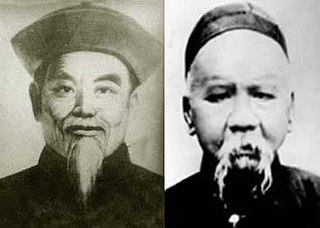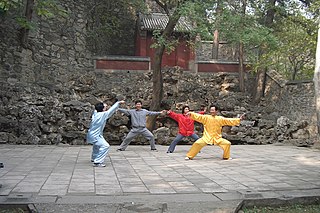
Tai chi is an ancient Chinese martial art. Initially developed for combat and self-defense, it has evolved into a sport and form of exercise. Tai chi is a gentle, low-impact form of exercise in which practitioners perform a series of deliberate, flowing motions while focusing on deep, slow breaths. Often referred to as "meditation in motion," tai chi aims to concentrate and balance the body's qi, providing benefits to mental and physical health.

The Wudang Mountains are a mountain range in the northwestern part of Hubei, China. They are home to a famous complex of Taoist temples and monasteries associated with the Lord of the North, Xuantian Shangdi. The Wudang Mountains are renowned for the practice of tai chi and Taoism as the Taoist counterpart to the Shaolin Monastery, which is affiliated with Chan Buddhism. The Wudang Mountains are one of the "Four Sacred Mountains of Taoism" in China, an important destination for Taoist pilgrimages. The monasteries such as the Wudang Garden were made a UNESCO World Heritage Site in 1994 because of their religious significance and architectural achievement.

Wu (Hao)-style tai chi is one of the five primary styles of tai chi. It was created in the mid-nineteenth century by Wu Yuxiang, a member of a wealthy and influential family in Yongnian, Hebei, China. Wu trained for approximately ten years with the founder of Yang-style tai chi, and then for over a month with a Chen-style master. Wu also obtained a manual on internal martial arts that formed the core of what are now known as the tai chi classics and include Wu's own writing on the subject. From these sources Wu and his family developed their own style, and may also have developed much of the cultural and intellectual foundation of tai chi as well.

The Chen-style tai chi is a Northern Chinese martial art and the original form of tai chi. Chen-style is characterized by silk reeling, alternating fast and slow motions, and bursts of power.

Handan is a prefecture-level city located in the southwest of Hebei province, China. The southernmost prefecture-level city of the province, it borders Xingtai on the north, and the provinces of Shanxi on the west, Henan on the south and Shandong on the east. At the 2010 census, its population was 9,174,683 inhabitants whom 2,845,790 lived in the built-up area made of 5 urban districts. Yongnian District in Handan and Shahe City in Xingtai have largely formed into a single conurbation.

The Battle of Hulao, or Battle of Sishui, was a decisive Tang victory over the rival Zheng and Hebei-based Xia polities during the transition from Sui to Tang. The battle took place during the Luoyang–Hulao campaign on 28 May 621 when a Xia army – led by Dou Jiande, ruler of Xia – was defeated attacking a smaller Tang army – led by Prince Li Shimin – entrenched at the strategic Hulao Pass.

Yang Shaohou was a Chinese martial arts master who, along with Yang Chengfu, represents the third generation of Yang-style tai chi. Grandmaster of his generation and known for his compact "small frame" techniques, he was a ferocious fighter and a demanding teacher.
Liu Heita was an agrarian rebel leader during China's transition period from the Sui dynasty to the Tang dynasty, who initially successively served under Hao Xiaode (郝孝德), Li Mi, and Wang Shichong. He eventually followed Dou Jiande the Prince of Xia. After Dou was killed by Emperor Gaozu of Tang in 621 and his territory was taken by Tang, Liu rose to avenge Dou, and briefly recaptured Dou's territory, north of the Yellow River.
The Diocese of Yongnian/Weixian is a Latin Church ecclesiastical territory or diocese located in the city of Yongnian, China. It is a suffragan diocese in the ecclesiastical province of the metropolitan Archdiocese of Beijing.

is a county of central Fujian province, People's Republic of China. It is placed under the jurisdiction of the Sanming City.

She County, or Shexian, is a county of southwestern Hebei Province, China, located on the lower reaches of the Zhang River and bordering Shanxi to the west and Henan to the south. It is under the administration of the Handan City, with a population of 400,000 residing in an area of 1,509 km2 (583 sq mi).
Yongnian is an urban district of the city of Handan, Hebei province, China. It is the seat of the Roman Catholic Diocese of Yongnian.
Ming Prefecture, also known by its Chinese name Mingzhou, was a prefecture (zhou) of imperial China in present-day Hebei Province. It existed intermittently from AD 578 to 1278. Its seat—also known at the time as Mingzhou—was at Guangfu in Handan's Yongnian District.

Dong Yingjie was a leading master of tai chi, and a top disciple of Yang Chengfu. Born in Renze, Xingtai, Hebei, China, his given name was Wenke (文科). Famous in his time for defeating a foreign boxer in a public challenge match, he dedicated his life to the martial arts, training intensively in multiple styles, serving as chief assistant instructor for Yang Chengfu, and going on to found his own thriving tai chi legacy.

Yang Luchan, also known as Yang Fukui (1799–1872), was an influential Chinese practitioner and teacher of the internal style tai chi. He is known as the founder of Yang-style tai chi, the most popular and widely practised tai chi style in the world today.

"Beijing" is from pinyin Běijīng, which is romanized from 北京, the Chinese name for this city. The pinyin system of transliteration was approved by the Chinese government in 1958, but little used until 1979. It was gradually adopted by various news organizations, governments, and international agencies over the next decade.
Hong Junsheng, born in 1907 in Henan, China, was a Chinese martial arts practitioner, teacher and author. Hong was the longest serving disciple for the Chen-style tai chi master Chen Fake. Starting in 1930, Hong trained uninterrupted with Chen for fifteen years. In 1944, Hong moved to the city of Jinan in Shandong Province. In 1956, he returned to Beijing to study again with his teacher, Chen Fake. Later, Hong expressed his understanding of Chen Fake's teachings of tai chi through his own teachings and writings. These theories and training principles are now known as the Chen-style tai chi Practical Method.
AAAAA is awarded to the most important and best-maintained tourist attractions in the People's Republic of China, given the highest level in the rating categories used by the Ministry of Culture and Tourism. As of 2020, there are 279 tourist attractions listed as 5A.

Xu Guangping, courtesy name Shuyuan, infant name Xia, was a Chinese female writer, politician, and social activist. She was well known as the partner of Chinese writer Lu Xun.

The House of the Huangcheng Chancellor, also known by its Chinese name, Huangcheng Xiangfu, is a 10-hectare (25-acre) walled estate on Phoenix Hill (Fenghuangshan) comprising Huangcheng, a village occupying a hollow above the Changhe Valley between Yangcheng and Jincheng in southeastern Shanxi, China. It is composed of numerous siheyuan-style courtyards built into the side of a hill, overlooked by defensive towers and enclosed by high crenellated walls that divide it into two sections. The fortifications were built in the seventeenth and eighteenth centuries, during the late Ming and early Qing dynasties.



















